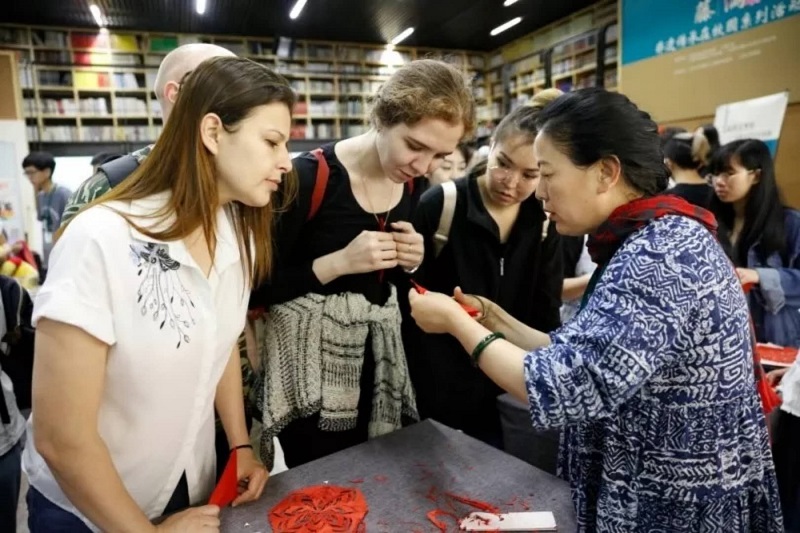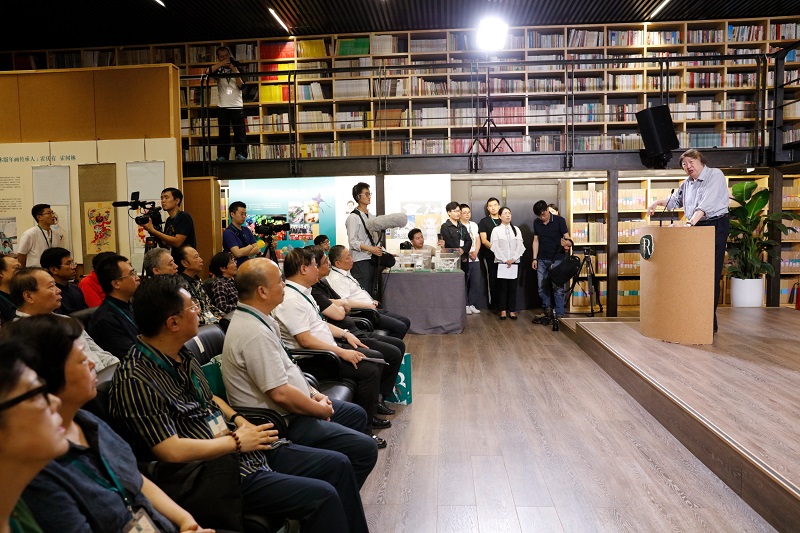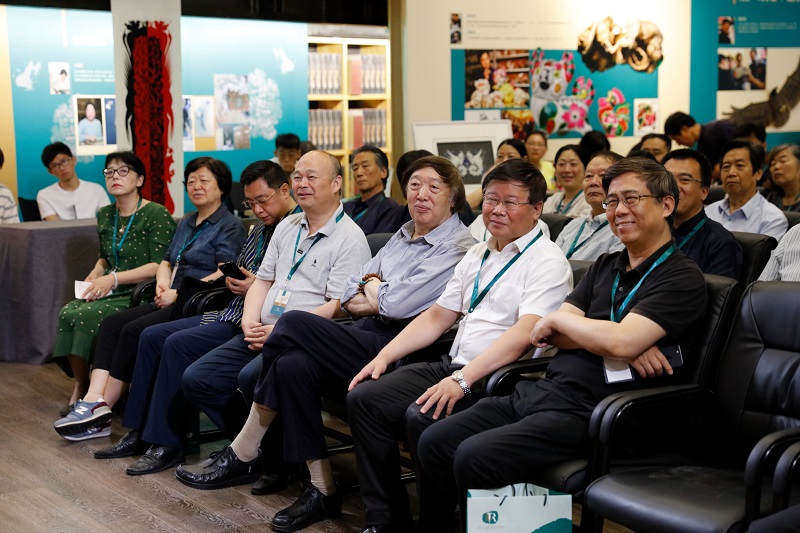
It has been 13 years since China established the "Cultural Heritage Day" in 2006. On June 9, Chinese Cultural Heritage Day, with the theme of “Intangible Cultural Heritage Inheritance on Campus”, the Feng Jicai Research Institute of Literature and Art of Tianjin University organized a series of activities, gathering a number of national-level inheritors of intangible cultural heritage and folk cultural scholars as well as attracting many college faculty and students and citizens. Intangible cultural heritage has infiltrated into students' cultural life and made an impression on campus.
In midsummer, the courtyard of the Feng Jicai Research Institute of Literature and Art of Tianjin University is delightfully cool. The wall is overgrown with verdant ivy. The yard is surrounded by shady trees with fancy carp swimming in the pond. The activities brought new life to the courtyard. The entrance was hung with two colorful 2-meter-long “tiger strings” of cloth tigers, birthday peaches, rice dumplings, peppers, brooms and sachets, together with a huge cloth tiger squatting on the floor. All of these celebrated the custom of the Tianjin in Dragon Boat Festival. For the Chinese Cultural Heritage Day, a number of inheritors of intangible cultural heritage, folk cultural scholars, and college faculty and students came to share the special holiday with talk and playful interaction.

The opening ceremony of the activities was held in Lecture Hall of Feng Jicai Research Institute of Literature and Art. The Lecture Hall was decorated by all kinds of folk handicrafts including blue calico, Xianju flower lanterns, Fengxiang Clay Sculptures, Tianjin Kites, Beijing paper sculptures, Yangliuqing New Year Pictures and Shanxi paper cuttings. These works are made by inheritors of intangible cultural heritage, of whom many are national-level inheritors. The students of Tianjin University also showed their works. The students of the Guqin association played guqin (a plucked seven-string Chinese musical instrument of the zither family) while the Tibetan students of the Xianzi Guozhuang Association performed dances. Finally, Professor Feng Jicai, a well-known writer, artist and scholar, a counselor to the State Council, and Director of Feng Jicai Research Institute of Literature and Art of Tianjin University, delivered a speech.
After the ceremony, the activities were divided into three parts.
The first part is opening ceremony of an oral history investigation of Huanghui, which represents folk culture of Tianjin. Through a 4-year centralized survey, Feng Jicai Research Institute has completed an art item for the National Social Science Fund of China that is a Research Project on Tianjin Huanghui in the Transitional Period of Modern Society. It has also published culture files for ten Laohui including West Wharf Bairen Beijing Yangko Laohui, which won the 12th Mountain Flower Award of Chinese Folk Literature and Art and the 14th Tianjin Social Sciences Excellent Achievement Award. However, files of many historically far-reaching Laohui can’t be found now. As for other Laohui, though the files are scattered, the successors are still alive. It has been more than 80 years since the last Huanghui in 1936, so it is necessary to use oral history methods to rescue relevant memories. Therefore, the Feng Jicai Research Institute initiated the oral history investigation of “The Last Memory of Huanghui” on Chinese Cultural Heritage Day to look for the descendants, witnesses, and watchmen of the Laohui.
On the afternoon of the June 9, the successors and students hand-in-hand activities were full of fun and excitement. The students from paper folding, paper-cutting, handicrafts, calligraphy and painting associations of Tianjin University communicated with successors of Nantong blue calico, Fengxiang Clay Sculpture, Yangliuqing Folk Painting, Tianjin Weiji Kite, Zhejiang embroidery, Zhejiang Xianju flower lanterns, Shanxi paper cuttings and Beijing paper sculpture, teaching participants to make their own works. The students from various colleges and universities in Tianjin came here, and many faculty also came to experience it with their children. International students from all over the world were entranced by Chinese Intangible Cultural Heritage works.

On the afternoon of June 10, Feng Jicai Research Institute also launched the “Dashu Forum” where Feng Xiaocai had conversations with two renowned scholars. The theme of the Heritage Day Seminar was Localization of Intangible Cultural Heritage with Cultural Foresight and Cultural Consciousness. They are pioneers and advocates of the cultural heritage protection projects such as the "Rescue Works for Chinese Folk Cultural Heritage", introducing the concepts of "intangible cultural heritage" and "cultural heritage day" into China. Through telling personal experiences and in-depth dialogues, they showed the methods of system construction of Chinese intangible cultural heritage protection with cultural foresight to promote the localization of intangible cultural heritage protection. They also interacted with young students and the public to explore how to carry on cultural inheritance in daily life.
Professor Feng Jicai was the pioneer of Chinese Cultural Heritage Day. In the 1990s, he made a special trip to France to learn of the advanced experience of Western cultural heritage protection and found that the “Cultural Heritage Day” that was first established in France and later spread throughout Europe, greatly increased cultural pride and consciousness of European peoples. In 2004 and 2005, Feng Jicai twice called for the establishment of "Cultural Heritage Day" as a CPPCC proposal. In 2006, when the first "Cultural Heritage Day" was established, he made a speech on "The Significance of Cultural Heritage Day” at the National Library. His new concept of inheritance and the concept of intangible cultural heritage protection has inspired and had far-reaching influence on the whole country.
Feng Jicai believes that the Cultural Heritage Day is self-conscious civilization, embodying the civilization consciousness of the current generation of Chinese people. Besides the government, experts and scholars, the public should also treasure and protect cultural heritage because the people are the creators of culture. The culture would ultimately become extinct without people’s protection and inheritance. Therefore, with stress on its spiritual significance, the Heritage Day aims to encourage people to be active participants with cultural consciousness.
Since its establishment in 2005, Feng Jicai Research Institute of Literature and Art of Tianjin University has been dedicated to bringing intangible cultural heritage and excellent folk culture into the campus. It has held two “Peiyang Culture Festivals” and numerous exhibitions and academic forums on intangible cultural heritage, so that university students actively inherit Chinese traditional culture with the cultural experience. Today, there are a large number of associations related to “intangible cultural heritage”, which shows that “intangible cultural heritage” has become an integral part of the students’ cultural life. Students are entertaining themselves in the inheritance and creation of “intangible cultural heritage”, and Cultural Heritage Day has gradually become their own cultural festival.
The activities with the theme of “Intangible Cultural Heritage Inheritance on Campus” was sponsored by the Chinese Folk Literature and Art Association, Tianjin University, Tianjin Nankai District Culture and Tourism Bureau, and the Feng Jicai Tianjin Folk Cultural Foundation and organized by the Feng Jicai Research Institute of Literature and Art of Tianjin University and the Tianjin University Youth League Committee.
By: Li Yanqi
Editors: Sun Xiaofang and Ross Colquhoun






